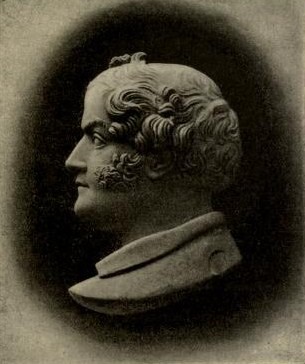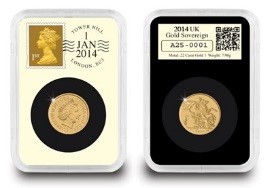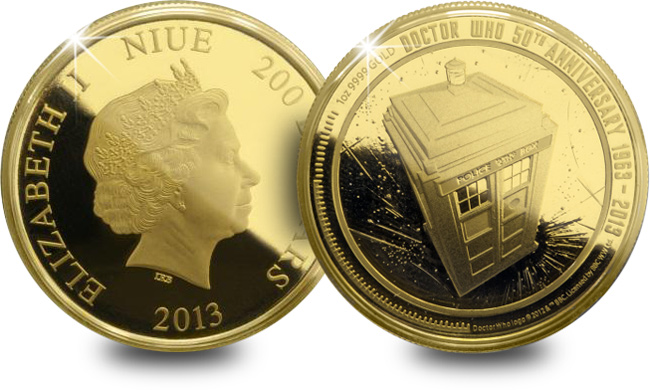New Issues
2014 Year of the “Mule”: the Royal Mint confirms Lunar Year and Britannia striking errors
If you own the 2014 Year of the Horse Lunar Silver Coin or the 2014 Britannia coin, I suggest you go and dig them out before you read any more. That’s because it’s just possible that you are sitting on something rather unusual – a Royal Mint “mule”.
A “mule” is a coin where the one of the sides has been struck with the wrong die. And that’s what happened with some of the Royal Mint’s 2014 Year of the Horse and Britannia coins.
Officially confirmed by the Royal Mint
It seems attention was first drawn to the matter when a US dealer noticed that some of their Britannia coins had a different obverse (heads) side to the rest of the stock, lacking the denticle design around the edge, normally seen with Britannia coins.
The Royal Mint has now acknowledged the error, which has resulted in approximately 17,000 Britannia coins being struck with the non-denticled Year of the Horse obverse and 38,000 Year of the Horse coins having the denticled Britannia version as their obverse.
Selling for 250 times its original value
Perhaps the best recent example of a UK mule in recent years was the undated 20p coin, which was uncovered in 2008. Approximately 250,000 20p coins were struck using an old obverse design, which left them undated. The news was followed by a media frenzy with many millions of people searching their change in the hope finding what was to prove to be a valuable error. Indeed an undated 20p currently changes hands on ebay for around £50 – 250 times its original value.
So what of these latest Royal Mint errors? Unlike the 20p these are not general circulation coins but as bullion coin they will have been sold around the world to coin dealers and investors. That means that they will be much harder for the British general public to track down. Plus, of course, in terms of pure numbers struck, they are considerably scarcer than the undated 20p.
Early listings on ebay have been as high as £500 and above, so if you are lucky enough to own either the 2014 Britannia or Year of the Horse coins, I would definitely dig them out and take a look – it might be your lucky day.
The Making of a British Icon
How an Italian engraver produced the most British coin of all time
Across the world, one coin is seen to epitomise all that it is British in a way that compares with nothing else. That coin is the Gold Sovereign. And at the centre of its international reputation is a quintessentially British design – St. George slaying the dragon.
Yet it is not, as you may first think, the work of a classical British artist, but instead that of the second son of an Italian federal court judge, who only came to England just two years before his portrayal of St. George and the Dragon first adorned a British coin in 1817.

Cameo of Benedetto Pistrucci, by his daughter c. 1850
In fact well before his arrival in England in 1815, Pistrucci was already well established as a leading gem engraver and producer of fine cameos amongst European high society. He rapidly made an impression on his arrival in London, winning the approval of the well-known antiquarian William Richard Hamilton.
Despite having no coin or medal experience, he was quickly commissioned by the Master of the Mint Wellesley Pole, brother of the Duke of Wellington, to produce a new portrait of George III as part of the Great Recoinage. His model, created in the unusual medium of red jasper, was re-engraved by Thomas Wyon for its final use on coinage losing, in Pistrucci’s eyes at least, much of the detail.
However, his work was clearly of sufficient quality to impress Pole, who followed up with a commission for the design that has forever since been the synonymous with the name Benedetto Pistrucci – St. George and the Dragon.
A design nearly lost the annals of history
Yet within just eight years it looked like Pistrucci’s design might disappear forever, as the Royal Mint changed the Sovereign reverse design to an heraldic shield, which was to remain in place for the next 46 years.
It was only a drive to improve the design quality of the coinage, led by new Deputy Master, Charles Fremantle that saw the re-introduction of St. George in 1871. However, both reverse designs were struck concurrently until 1887 when the Chancellor of the Exchequer declared that “by tradition and recommended by the great beauty of the design” Pistrucci’s design should once again appear on all Gold Sovereigns.
“The chief coin of the world”
By the mid-1850s the “new” Gold Sovereign had become a coin of true international status. Indeed an official list identifies no fewer than thirty-six colonies and dependencies in which the gold sovereign or half sovereign was recognised as legal tender.
More surprisingly, so great had become the reputation of the British sovereign that it was also in regular use in other countries outside the Empire, including Brazil, Egypt and Portugal.
However, it was the opening of the Sydney branch of the Royal Mint in 1855 following the discovery of gold in Australia that really marked the international growth of the Sovereign. Initially authorised to strike Sovereign’s to a different design, in 1871 Sydney finally started to strike coins of the same designs as the UK (just in time for the Pistrucci revival), only identified by a small “S” mintmark.
Further Australian Royal Mint branches followed in Melbourne in 1871 and Perth in 1899, before the Mint’s reach extended to other Empire countries with branches opening in Ottowa (1899), Bombay (1918) and Pretoria (1923) – all producing Gold Sovereigns.
It is no wonder that the eminent economist of the early 20th Century, Sir John Clapham, proclaimed the Gold sovereign as “the chief coin of the world”.
A worldwide modern icon – good enough for 007
The last international sovereign was struck in Pretoria in 1932. By then the international interest in Gold Sovereign, which started in Victorian times was well and truly established. And it is a reputation that continues right up to today.
Ian Fleming chose to equip James Bond with 50 Gold Sovereigns in his attaché case in the From Russia with Love, whilst Special Forces are still believed to carry Gold Sovereigns, as an emergency international currency.
In 2012 the Royal Mint once again authorised the striking of the St. George and the Dragon Gold Sovereign outside the UK under licence in India, so great is its popularity amongst the people there.
Reference
“The Royal Sovereign 1489 – 1989”, Ed GP Dyer
“A New History of the Royal Mint”, Christopher Edgar Challis
The Royal Mint Museum Website
________________________________________________________________

The 2014 Gold Sovereign is available in a limited edition DateStamp™ Presentation of just 995 pieces –now sold out.
Doctor Who coin sells for 15 times its face value!
The New Zealand Mint were amazed when a Limited Edition Doctor Who Silver Coin, issued in collaboration with BBC Worldwide to celebrate the 50th Anniversary of the legendary TV show, created a bidding frenzy!
The Mint had put the coin on eBay as part of a charity auction and when the auction ended the winning bid was an incredible 15 times more than its face value! It just shows how popular Doctor Who memorabilia, particularly coins, is with collectors all over the world.
However, it’s not just on eBay where collectors have been fighting to add a Dr Who Commemorative coin to their collection. Within just four weeks of general release the Mint had sold more than half of the Doctor Who Silver Coin’s 10,000 edition limit. And now, just three weeks after the fantastic ‘Day of the Doctor’ 50th Anniversary episode was aired it is unlikely that the Mint have any left at all.
A Doctor Who 50th Anniversary Gold coin follows the success of the Silver coin, and with a mintage of just 250 worldwide this one will not be available for long either.
________________________________________________________________
The Doctor Who 50th Anniversary Silver coin.
Features the TARDIS in engraved relief on the reverse with coloured element. Comes in a special TARDIS presentation box complete with sound effects. Now sold out.
The Doctor Who 50th Anniversary 1oz Gold Coin
Features the TARDIS depicted in engraved relief on the reverse and presented in a deluxe wooden box. Now sold out.





